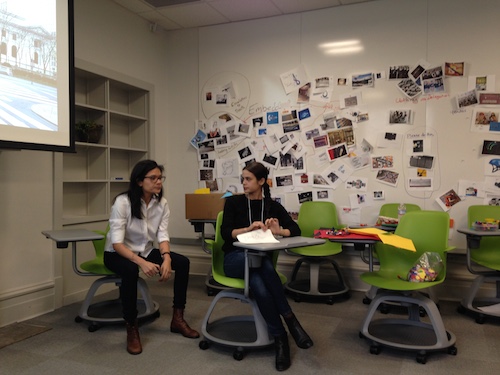By Mae Wiskin
The first thing I thought upon landing in Pittsburg was how much I wished I had packed gloves. I was freezing, but also completely enlivened by the fact that November had already come and it was finally time to participate in a symposium I had been looking forward to since the start of fall semester. From November 7 – 9, Parsons The New School for Design – Design Studies masters students collaborated with the doctoral candidates of Carnegie Mellon University’s School of Design on a workshop concerning ‘Mattering.’ More specifically, students from both Universities discussed and delved into the notion of “(How design makes) What matters (Matter for us).”

Parsons Design Studies MA students Mae Wiskin and Rachel Smith enacting a scenario of delegated morality by design at the Matter(ing) workshop at Carnegie Mellon University.
The one-day symposium explored the dynamic interactions between human behavior and information technologies, as well as the multidimensional relationship designed objects share with the concept of morality. Prior to arriving at CMU, each of us was asked to come up images of twenty things that “delegated morality,” things such as seatbelts, security devices, and automatic timers that regulate energy consumption. Once I was able to wrap my head around how we delegate our moral agency to things, I could not maneuver through New York City without constantly noting such objects. It became a sort of game and encouraged me to question what it means to be human in an increasingly monitored, digital world. The issues we explored over the course of the symposium paved the way for a larger scale design thinking conference that will be held at Parsons in March 2015.
Once the workshop ended, everyone slowly parted ways and disappeared into the cold Pennsylvania air to enjoy the pleasures of Pittsburgh on a Saturday night. The discourse presented at the symposium was intellectually rigorous; I left Carnegie Mellon feeling invigorated and excited to explore the notion of ‘mattering’ further.

Parsons MA DS Students at Fallingwater. Back row, l to right: Laura Sanchez, Mae Wiskin, Susan Yelavich, Misha Volf, Olly Bolton, Estefania Acosta, Laura Wing; middle row: Micki Unterberg, Rachel Smith, Sonja Holopainen, Quizayra Gonzales; front row: James Laslavic, Gene Duval, Maggie Lin, Juan Pablo Pemberty, Veronica Uribe.
The following morning, before returning to New York, our energetic director, Susan Yelavich, treated us all to a trip to visit Fallingwater (1934-39), a very rare home built over a waterfall by America’s most famous architect, Frank Lloyd Wright. It was a beautiful crisp autumn day and the modernist icon was absolutely awe-inspiring. We all left rejuvenated and ready to return to the city with a fresh sense of perspective and energy. The trip was really special and reminded me not only how lucky I am to be a member of a program that encourages disruptive and innovative thought, but also, that it was time to buy winter gloves.
